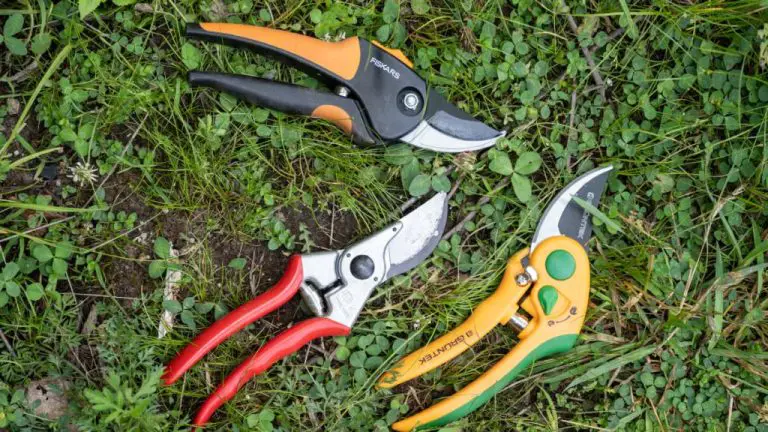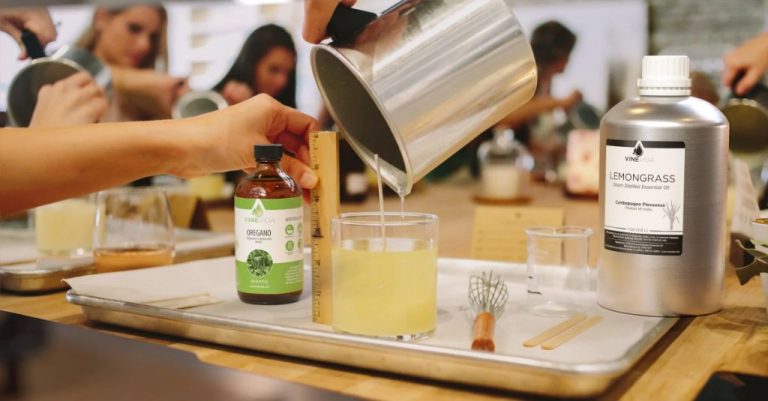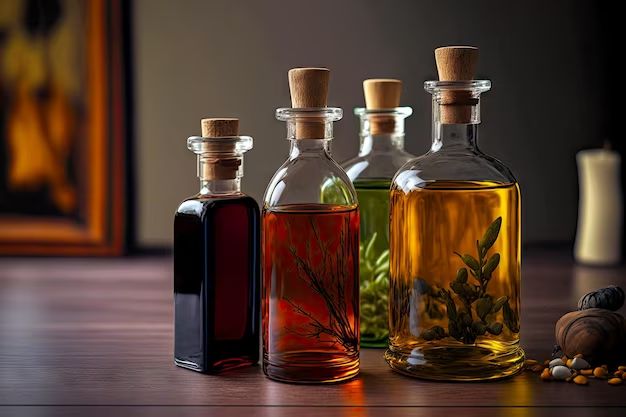What Is The Ratio Of Essential Oil To Candle Wax?
Essential oils are highly concentrated extracts taken from plants which are popular for their aromatic properties. Candle wax refers to the base that holds the flame of a candle and is often made from paraffin wax, soy wax, beeswax, or other waxes. The purpose of adding essential oils to candle wax is to infuse the candles with pleasant scents when burned. Determining the optimal ratio of essential oil to candle wax involves balancing factors like scent intensity, burn safety, and cost. The general recommendation is to use a ratio of around 1-2% essential oil to wax, though the ideal amount can vary based on the type of oil, wax, vessel, and desired strength of scent.
Factors That Determine Ratio
The ratio of essential oil to candle wax depends on several key factors:
- Candle wax type – Different waxes have different capacity for holding fragrance oils. For example, soy wax generally has a fragrance load between 5-10% of the wax weight. Paraffin wax can hold up to 12% fragrance load. Beeswax has a lower fragrance load around 3-5%. The wax type determines the maximum amount of fragrance the candle can hold.
- Fragrance load limits – Each wax has a maximum fragrance load limit that should not be exceeded to maintain proper candle performance. Going above this limit can lead to issues like fragrance throw, scent mixing, and more. Staying within the fragrance load limit ensures the wax holds the oil properly.
- Essential oil strength – Some essential oils like lemon and peppermint are very concentrated and intense. Others like lavender and chamomile are milder. The strength of the oil impacts how much needs to be added. Strong oils require less quantity.
Recommended General Ratios
There are some general guidelines for essential oil ratios when making candles with different wax types:
For soy wax, a ratio of 1-2% essential oil per pound of wax is typically recommended. Soy wax has a lower melting point than other waxes, so it requires less fragrance [1].
With paraffin wax, a higher fragrance load between 5-8% essential oil per pound of wax is common. Paraffin wax can hold more fragrance than soy [2].
For beeswax candles, up to 10% essential oil per pound of wax is generally the maximum recommended. Beeswax has a delicate honey aroma, so strong essential oils can easily overwhelm it.
Ratios by Essential Oil
The ratio of essential oil to candle wax can vary depending on the strength of the essential oil’s scent. Stronger scented oils like lavender, eucalyptus, and lemon grass require less oil, while lighter scents like chamomile, rose, and neroli require more.
Here are some general guidelines for essential oil to wax ratios based on oil strength:
- Strong scents (lavender, eucalyptus, lemon): 1-2% ratio
- Medium scents (bergamot, tea tree): 2-3% ratio
- Mild scents (chamomile, rose): 3-4% ratio
For example, an 8 oz candle with a 1% lavender oil ratio would need about 5-6 drops of oil. The same 8 oz candle with a 4% chamomile ratio would need 20-24 drops. Testing different ratios with your specific wax and oils is important to find the right balance.
Source: https://www.rockymountainoils.com/blogs/essential-oil-basics/how-much-essential-oil-to-add-to-candle
Testing and Adjusting

It’s important to test your candles to ensure you have the ideal ratio of essential oils to wax. Too much or too little oil can impact performance.1 Here are some signs your candle has too much or too little oil and tips for adjusting the ratios:
Signs of too much oil:
- Overpowering scent
- Oily spots or residue on the glass
- Smoke or soda bubbling while burning
Signs of too little oil:
- Faint or no scent
- Poor scent throw
To tweak ratios:
- Reduce oil by 0.5% increments if too strong
- Increase oil by 0.25-0.5% increments if too weak
- Test again after each adjustment
Finding the right essential oil to wax ratio requires patience and testing. Start with recommended amounts and fine-tune based on performance.
Safety Precautions
When making candles with essential oils, it’s important to take safety precautions. Proper ventilation is crucial, as the oils and wax can release volatile organic compounds when heated. Make sure to burn candles in well-ventilated areas and never leave burning candles unattended (source).
Additionally, avoid using potentially harmful essential oils like wintergreen, clove, thyme, cinnamon, and oregano in candles, as they can be toxic when burned (source). Stick to safer options like lavender, lemon, peppermint, and tea tree.
It’s also important to use the proper wick size for the candle jar, oil blend, and wax type. This helps ensure proper burning and minimizes soot (source). Test different wick sizes when formulating a new candle to find the best fit.
Storing Candles with Oils
Essential oils can impact the shelf life of candles. According to Nikura, candles with natural ingredients like essential oils or soy wax are best used within a few months (source). BHG also notes essential oil candles tend to degrade after about two years (source).
To maximize shelf life, proper storage is important. CandleScience recommends storing essential oil candles in an airtight container in the refrigerator, separately from food to prevent cross-contamination (source). This helps preserve the essential oils and prevent degradation. Proper storage in a cool, dark place can extend the shelf life of essential oil candles.
Scent Throw
Maximizing a candle’s fragrance, also known as its scent throw or hot throw, is key to creating a pleasing aromatherapy experience. Scent throw refers to the fragrance intensity when the candle is lit and wax is pooled, while cold throw refers to the smell when unlit. There are a few factors that impact hot throw:
Proper candle wax selection is important, as some waxes hold fragrance better than others. Paraffin, soy, and beeswax are common picks. Using too little or too much fragrance oil can reduce throw. The standard ratio is 6-10% of the wax weight, but testing is needed. Wicking also matters, as the flame size impacts how quickly and evenly the wax melts and releases fragrance. Lastly, curing candles for 1-2 weeks allows the fragrance oil to fully bind to the wax for stronger hot throw.
For cold throw, headspace of around 1/4″ between the wax and jar top is ideal for aroma release. Proper preparation and storage of candle wax and fragrance oils also preserves cold throw over time. While essential oils have great aroma, higher concentrations are often needed in candles compared to synthetic fragrance oils due to volatility.
Other Considerations
There are a few other factors that can affect the ideal essential oil to wax ratio when making candles.
Dye and Other Additives
Adding dyes, fragrances, or other ingredients will impact how the wax holds onto scent. More additives usually mean you need a higher percentage of essential oils. Test candles with additives to see if you need to increase the oil ratio.
Vessel Type
The type of vessel can impact scent throw. Containers like tin or glass tend to contain scent better than porous materials. You may need a lower oil ratio for well-sealing containers.
Budget
Essential oils are one of the more costly ingredients. Those on a tight budget may need to use less oil. But this could compromise scent throw. Consider lower cost oils or waiting until you can afford more to strengthen the fragrance.
Conclusion
When it comes to essential oil to wax ratios for candles, there are a few key takeaways:
– Test out ratios first before making large batches. Ratios can vary greatly depending on oil strength, density, fragrance throw, and more. Start with recommended general ratios based on oil type, then adjust up or down based on your testing and preferences.
– Use caution and care when working with essential oils. Many are skin irritants or sensitizers. Wear gloves, work in a ventilated area, and research any safety precautions for specific oils.
– Store finished candles properly to help preserve scent. Keep out of high heat, light, and humidity. Candle jars should have tight lids.
– Most candlemakers recommend keeping oil ratios below 5% at the highest. High ratios can lead to burning issues. If a low ratio isn’t providing enough scent, use oils with better throw or add fragrance.
– Follow best practices for mixing, pouring, curing, and burning to get the most out of essential oil candles. Proper wick size, wax melting point, jar shape, and burn time will all affect scent diffusion.
By understanding how to balance essential oil ratios with wax, wicks, and more, candlemakers can create safe, long-lasting, and delightfully scented homemade candles. Test, adjust, and find the ideal mixes for your unique oil blends and recipes.






